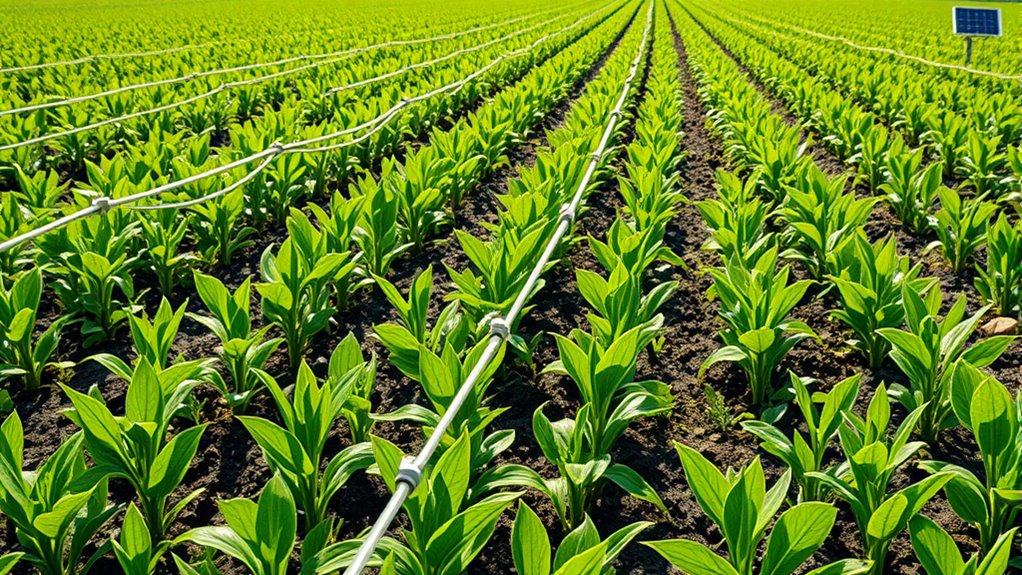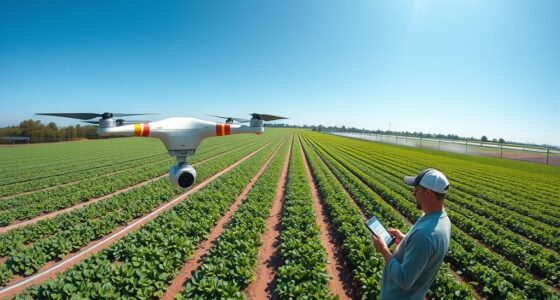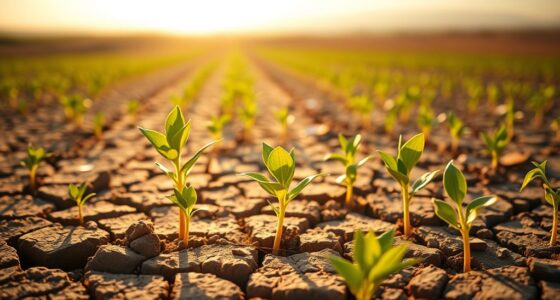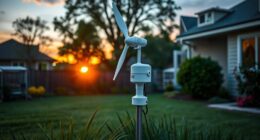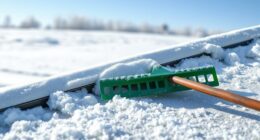To conserve water with precision irrigation, you should use soil moisture sensors and real-time data analysis. These technologies monitor water levels accurately and help you make informed watering decisions. Proper calibration and regular maintenance guarantee the sensors provide reliable data. By adopting these tools, you reduce waste, save energy, and promote healthier crops. Keep exploring to discover how integrating these systems can maximize efficiency and sustainability on your farm.
Key Takeaways
- Incorporate soil moisture sensors to deliver real-time data for targeted watering, reducing water waste.
- Regular calibration of sensors ensures accurate readings, optimizing irrigation schedules and conserving water.
- Maintenance practices like cleaning sensors prevent malfunctions, maintaining reliable data for efficient water use.
- Use automated precision irrigation systems that adjust watering based on sensor data and environmental conditions.
- Combine soil moisture monitoring with weather forecasts to adapt irrigation, preventing overwatering and enhancing water efficiency.

Precision irrigation technologies are transforming the way farmers water their crops by delivering water exactly where and when it’s needed. This approach relies heavily on accurate data, especially regarding soil moisture levels, to optimize water use and prevent waste. When you implement these systems, you need to understand that soil moisture sensors are at the core of precision irrigation. These sensors measure the water content in the soil, providing real-time data that helps determine when and how much water your crops require. However, the effectiveness of these sensors depends on proper calibration. If your sensors aren’t calibrated correctly, they can give misleading readings, leading either to overwatering or underwatering. Regular sensor calibration ensures that the moisture levels reported align with the actual soil conditions, enabling you to make informed irrigation decisions.
Calibrating soil moisture sensors involves comparing sensor readings with manual soil moisture tests at various depths and moisture levels. You might need to adjust the sensor’s settings or input correction factors so that the readings accurately reflect the soil’s true moisture content. This process can be straightforward but requires consistency and careful attention to detail. Proper calibration not only improves the accuracy of your soil moisture data but also enhances the overall efficiency of your irrigation system. When the sensors are correctly calibrated, you avoid unnecessary watering, which conserves water and reduces energy costs, while also promoting healthier crop growth.
In addition to calibration, maintaining the sensors is essential. Dirt, debris, and weather conditions can affect sensor performance over time. Regular inspection and cleaning ensure your soil moisture sensors continue to operate correctly, providing reliable data for your irrigation scheduling. Incorporating proper sensor maintenance can significantly extend the lifespan and accuracy of your equipment. Combining sensor calibration with proper maintenance creates a robust system that adapts to changing soil conditions throughout the growing season. This adaptability is fundamental because soil moisture levels fluctuate due to weather, crop growth stages, and other environmental factors.
Frequently Asked Questions
How Does Soil Type Affect Precision Irrigation Effectiveness?
Soil type markedly impacts precision irrigation effectiveness because soil heterogeneity causes uneven water absorption. You may face drainage challenges in clay soils, which retain water longer, while sandy soils drain quickly, risking under-watering. By understanding these differences, you can adjust your irrigation system accordingly, ensuring consistent moisture levels. This tailored approach helps optimize water use, reduces waste, and improves crop health despite varying soil conditions.
What Are the Initial Costs of Implementing Precision Irrigation Systems?
You’ll find that initial costs for precision irrigation systems vary based on size and technology, but a thorough cost analysis helps you plan effectively. While upfront expenses can seem high, many farmers benefit from financial incentives or grants that offset costs. Investing now can lead to long-term savings through reduced water and energy use, making the system a smart financial decision in the long run.
Can Precision Irrigation Be Integrated With Existing Farm Equipment?
A stitch in time saves nine, and yes, you can incorporate precision irrigation with your existing farm equipment. By focusing on automation integration and equipment compatibility, you guarantee seamless operation. Many modern systems are designed for compatibility, making upgrades easier. You just need to check the specifications and work with providers to customize solutions, saving you both time and money while optimizing water use efficiently.
How Does Weather Variability Impact System Performance?
Weather variability can challenge your precision irrigation system’s performance, but it also boosts climate resilience and crop adaptation. When unpredictable weather occurs, your system adjusts watering schedules based on real-time data, helping you conserve water and protect crops. By responding to changing conditions, you guarantee better crop health and yield stability despite climate fluctuations. This adaptability makes your farm more resilient and better prepared for future weather uncertainties.
What Training Is Needed for Farmers to Operate These Technologies?
Think of mastering precision irrigation as planting seeds of knowledge. You’ll need farmer education focused on interpreting sensor data and system controls. Attending technology workshops helps you understand how to operate and troubleshoot new tools confidently. Hands-on training ensures you can adjust settings for maximum water use. With dedicated learning, you’ll harness these innovations effectively, turning technological potential into sustainable water conservation success on your farm.
Conclusion
Imagine your garden thriving while you save every drop of water—precision irrigation is your secret. Just like a skilled chef uses the right amount of spice, these technologies deliver just enough water exactly where it’s needed. Studies show you can reduce water use by up to 30% without sacrificing crop yields. Embrace these innovations, and you’ll not only conserve water but also grow healthier crops, proving that small adjustments can make a big difference for our planet.
